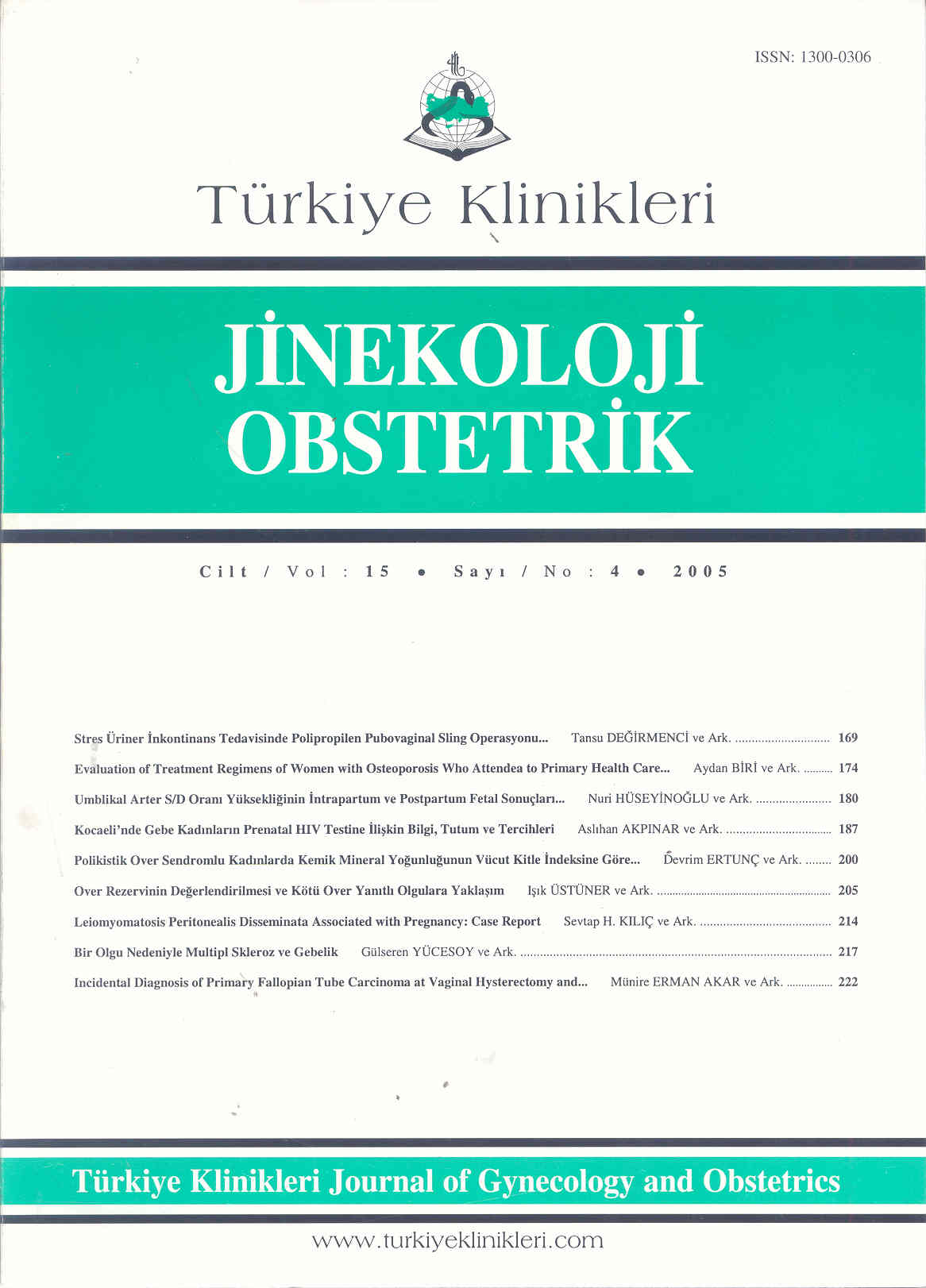Open Access
Peer Reviewed
REVIEW
3316 Viewed1352 Downloaded
Assessment Of Ovarian Reserve And Clinical Management Of Poor Responder Patients
Over Rezervinin Değerlendirilmesi ve Kötü Over Yanıtlı Olgulara Yaklaşım
Turkiye Klinikleri J Gynecol Obst. 2005;15(4):205-313
Article Language: TR
Copyright Ⓒ 2025 by Türkiye Klinikleri. This is an open access article under the CC BY-NC-ND license (http://creativecommons.org/licenses/by-nc-nd/4.0/)
ÖZET
Stimulasyon rejiminin bireyselleştirilmesi, over rezervinin analiz edilerek over yanıtının önceden belirlenebilmesi, kontrollü ovaryan hiperstimulasyon için önemli kriterlerdendir. Bir ovaryan stimulasyon rejimi sırasında kötü over yanıtı çok nadir olmayarak karşımıza çıkmakla birlikte, kötü over yanıtı için uniform bir tanımlama yoktur. Tam olarak kabul edilmese de, en objektif kriterler arasında; standart bir ovaryan stimulasyon sırasında küçük folikülllerin gelişmesi ve düşük estradiol düzeyleri yer almaktadır. Şu an için hangi hastanın ovulasyon indüksiyon rejimine kötü yanıt vereceğini belirleyen ideal bir test yoktur ve kötü yanıt veren hastanın optimal stimulasyonu hala bir sorun olarak durmaktadır. Eğer bir hastada düşük over rezervi saptanır ise, hangi stimulasyon rejimi kullanılırsa kullanılsın ovaryan yanıtın iyi olmayabileceği akılda tutulmalıdır. Farklı tedavi rejimlerinin etkinliğini belirlemek için iyi düzenlenmiş, geniş kapsamlı, randomize kontrollü çalışmalara gereksinim duyulmaktadır.
Stimulasyon rejiminin bireyselleştirilmesi, over rezervinin analiz edilerek over yanıtının önceden belirlenebilmesi, kontrollü ovaryan hiperstimulasyon için önemli kriterlerdendir. Bir ovaryan stimulasyon rejimi sırasında kötü over yanıtı çok nadir olmayarak karşımıza çıkmakla birlikte, kötü over yanıtı için uniform bir tanımlama yoktur. Tam olarak kabul edilmese de, en objektif kriterler arasında; standart bir ovaryan stimulasyon sırasında küçük folikülllerin gelişmesi ve düşük estradiol düzeyleri yer almaktadır. Şu an için hangi hastanın ovulasyon indüksiyon rejimine kötü yanıt vereceğini belirleyen ideal bir test yoktur ve kötü yanıt veren hastanın optimal stimulasyonu hala bir sorun olarak durmaktadır. Eğer bir hastada düşük over rezervi saptanır ise, hangi stimulasyon rejimi kullanılırsa kullanılsın ovaryan yanıtın iyi olmayabileceği akılda tutulmalıdır. Farklı tedavi rejimlerinin etkinliğini belirlemek için iyi düzenlenmiş, geniş kapsamlı, randomize kontrollü çalışmalara gereksinim duyulmaktadır.
ANAHTAR KELİMELER: Over rezervi, ovaryan stimulasyon, kötü ovaryan yanıt
ABSTRACT
Individualization of stimulation regimens, analysis of ovarian reserve, and setting defined goals regarding ovarian response to stimulation are all necessary to effectively perform controlled ovarian hyperstimulation. Eventhough it is not a rare occasion to encounter with poor response during an ovarian stimulation, there is no uniform definition of a poor responder. Although not fully accepted, the most objective criterion for poor ovarian response include; small numbers of follicles developed or oocytes retrieved, and low estradiol (E2) levels after a standard stimulation protocol. There is not yet an ideal approach to predict which patient would response poorly to ovulation induction. The most commonly used tests include increased levels of day 3 FSH and E2, and decreased levels of inhibin B. Optimal stimulation of poor responder still remains a challenge. If decreased ovarian reserve is documented, it should be kept in mind a good outcome with IVF be not expected, no matter which stimulation protocol would be used. Future well-designed, large-scale, randomized and controlled trials are required to assess the efficacy of different management strategies.
Individualization of stimulation regimens, analysis of ovarian reserve, and setting defined goals regarding ovarian response to stimulation are all necessary to effectively perform controlled ovarian hyperstimulation. Eventhough it is not a rare occasion to encounter with poor response during an ovarian stimulation, there is no uniform definition of a poor responder. Although not fully accepted, the most objective criterion for poor ovarian response include; small numbers of follicles developed or oocytes retrieved, and low estradiol (E2) levels after a standard stimulation protocol. There is not yet an ideal approach to predict which patient would response poorly to ovulation induction. The most commonly used tests include increased levels of day 3 FSH and E2, and decreased levels of inhibin B. Optimal stimulation of poor responder still remains a challenge. If decreased ovarian reserve is documented, it should be kept in mind a good outcome with IVF be not expected, no matter which stimulation protocol would be used. Future well-designed, large-scale, randomized and controlled trials are required to assess the efficacy of different management strategies.
MENU
POPULAR ARTICLES
MOST DOWNLOADED ARTICLES





This journal is licensed under a Creative Commons Attribution-NonCommercial-NoDerivatives 4.0 International License.










